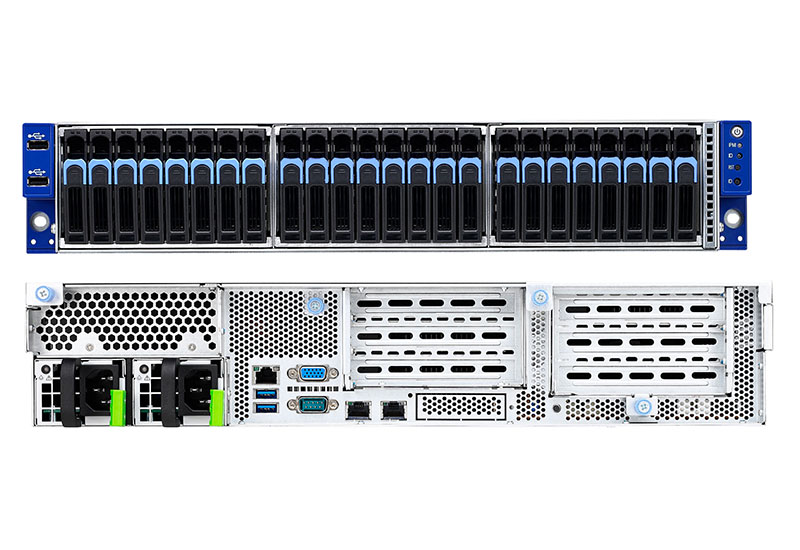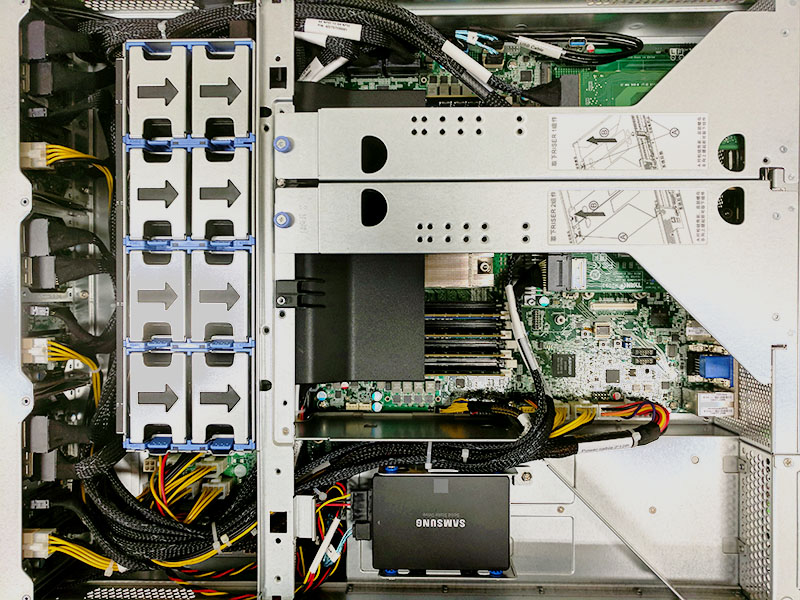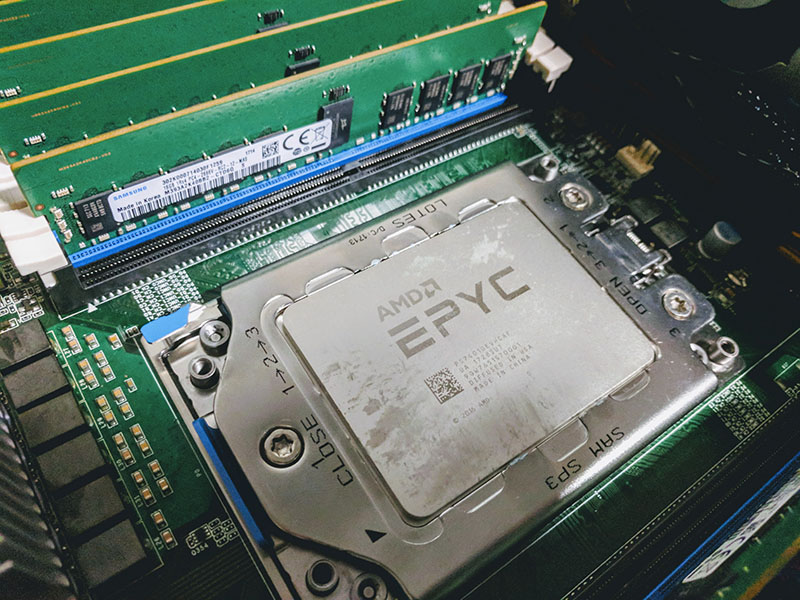AMD EPYC 7371 Test Configuration
At this point, we have had every public AMD EPYC SKU tested on a common Tyan EPYC platform save the AMD EPYC 7261 and the AWS EPYC 7571. Here is the base hardware configuration we are using:
- CPU: AMD EPYC 7371
- Server Barebones: Tyan Transport SX TN70A-B8026 (B8026T70AE24HR)
- RAM: 8x 16GB 128GB DDR4-2666 RDIMMs (Samsung)
- SSD: 1x Intel DC S3710 400GB SATA SSD, Intel Optane 905p 480GB
- NIC: 1x Mellanox ConnectX-3 Pro
Longtime STH readers will notice that we added an Intel Optane 905p 480GB NVMe SSD to this configuration. This was specific to some of the additional testing we are doing on this part using the STH web infrastructure. This is somewhat selfish, I wanted to see what the impact would be for our hosting infrastructure. Those results ended up being interesting enough that they made the cut for this review.

Key to this system is that it supports 24x NVMe U.2 NVMe SSDs without using Broadcom PLX PCIe expanders. That is 96 lanes of PCIe 3.0 directly from a single SKU. One of the key advantages AMD EPYC has is that a single EPYC CPU can use 128x PCIe lanes, the same number as the dual socket configuration. Tyan has responded to this opportunity by offering a single-socket system that can handle 24x NVMe drives plus have I/O available for 10/25/40/50/100GbE.

AMD and Tyan originally suggested that we use a Samsung SSD (as pictured), however, to aid in consistency, we are using our lab standard Intel DC S3710 400GB SSDs.

This is a great system that has worked well over the past several quarters. If you have an existing Intel Xeon E5 V1-V4 installation, it is likely that a single socket AMD EPYC 7000 series machine using NVMe drives can replace a dual socket or multiple dual socket previous generation servers. We have seen companies consolidate as many as four dual socket Intel Xeon E5-2620 V1 servers into a single AMD EPYC 7000 series server which is a great consolidation saving.
Next, we are going to benchmark the AMD EPYC 7371 before moving onto our market positioning and final thoughts.




On page 4 how do I know which terminal is for which processor?
I started reading and I was like whoa baby this is a 5 page CPU review why? Then I got into it at lunch and I know why. You’re right on the impact. That per-core performance is why we haven’t moved our Windows Hyper-V cluster to EPYC or even started to test it there.
You didn’t really mention it, but the clock speed also helps licenses in VMs. Maybe that’s obvious, but maybe to some it isn’t.
For SQL server you’re right that there’s other chips that might be better but those are extremely targeted products. It’s like EPYC’s first parts covered 75% of the market. These get them 20% more. Then there’s 5% that Intel still has better parts for.
Randy Bostrom if you look at the prompt text in those screenshots you’ll kick yourself. It’s a long review. It’s taken me 40 minutes to read.
CAN SOMEONE GET THESE GUYS GOLD 6142 CHIPS PLEASE
It can’t be that hard! Make it happen. @Intel if you don’t we’re gonna say you’re chicken.
I read STH reviews for “it is not released in a vacuum” phrase. What a peculiar feeling it triggers… Especially today, when it got paraphrased. And with a typo!
Patrick,
Why would you not have included the 7351P CPU into the “16 Core CPU Market” grid?
It is ~$400 cheaper than the 7351 CPUs, while providing (IIRC) the same performance. When talking about core-based licensing optimization it seems that this is the CPU model that is the “one to beat”.
{So much so that AMD really needs to make sure that they offer a 7371P variant, to help lock up that licensing market}
I’m with BinkyTO when is there going to be a 7371P version? I know what I want for Christmas. I’ll pay the power man.
It’s good to see AMD’s finally getting serious about frequency optimized. Maybe it’s better called performance per core optimized but that’s why we couldn’t use the EPYC that’s out there. Chips looked cheap but they’d cost too much for us to license servers for our environments. Your analysis is spot on.
6142 max all-core turbo is 3.3 GHz on 16 cores at around $2,950
Typo: Standard instead of Stanard
The base Windows Server 2019 license for Windows Server 2019 Stanard and Datacenter are 16 cores which
We we’re having this exact conversation in the office last week. We have about 40 Windows DC hosts. We’re RAM limited at 16C and 768GB. We want to EPYC but the single core is too low. This will fix
When in Q1?
That p5 SPEC CPU2017 here’s official data since I didn’t get it on the first read through
2x Gold 6130 164 https://www.spec.org/cpu2017/results/res2017q4/cpu2017-20171114-00735.html
2x EPYC 7351 165 https://www.spec.org/cpu2017/results/res2018q4/cpu2017-20180918-08912.html
2x Gold 6142 178 https://www.spec.org/cpu2017/results/res2017q4/cpu2017-20171211-01573.html
If Gold 6130 to 6142 is up to 500mhz more. EPYC 7351 to EPYC 7371 is 700MHz more, and more at the top single thread speed, then EPYC 7371 is going to do 185+. That wasn’t clear from the article on p5 but when I read the words then I looked at Cisco’s official results it make perfect sense. Maybe that’ll help someone else out
If they can do 4GHz at 225w crank it up. Intel’s been on this low power stuff for years but our data centers sell us metered power plus a cooling adder. 1 less server per rack would pay for 50-60w per server real quick.
If this comes in under $2k it’ll be a great value but you’ve still have to get people to welcome AMD again
Hopefully sth to go against the 6144 next.
I love STH for this review and analyst piece combined in one. They’re like analysts who have hands-on experience not just theoretical exposure.
For us, this is an important launch but not because we’re going to buy it. Our IT org will only buy second gen products. Rome would’ve been considered first gen for our Windows cluster. I’m going to put these in a RFP draft when they’re on the Dell site so I can get them nixed for being first gen. That’ll give me documentation to show Rome is a second gen product later in 2019. Next-level thinking here.
I was hoping for some 7nm EPYC by end of Q1/2019.
AMD has a once in a lifetime chance against Intel with Milan, they better hurry up to enjoy it as long as possible.
I buy some EPYC 7371 today for around 1550 USD. This price is absolutly fantastic and intel have nothing competive.
What cooler did you guys use? The Tyan heatsink says it doesn’t support the 200 watt processor.